Efficacy and Adverse Events in Metastatic Melanoma Patients Treated with Combination BRAF Plus MEK Inhibitors Versus BRAF Inhibitors: A Systematic Review
Abstract
1. Introduction
2. Methods
2.1. Literature Search
2.2. Literature Selection Criteria
2.3. Data Extraction
2.4. Definition of Outcomes
2.5. Statistical Analysis
2.6. Publication Bias
3. Results
3.1. Study Selection
3.2. Survival Outcomes
3.3. Pyrexia and Other Constitutional Adverse Events
3.4. Gastrointestinal Adverse Events
3.5. Cardiac Adverse Events
3.6. Dermatology Adverse Events
4. Discussion
5. Conclusions
Supplementary Materials
Funding
Acknowledgments
Conflicts of Interest
References
- Siegel, R.L.; Miller, K.D.; Jemal, A. Cancer statistics, 2019. CA Cancer J. Clin. 2019, 69, 7–34. [Google Scholar] [CrossRef] [PubMed]
- Pasquali, S.; Hadjinicolaou, A.V.; Chiarion Sileni, V.; Rossi, C.R.; Mocellin, S. Systemic treatments for metastatic cutaneous melanoma. Cochrane Database Syst. Rev. 2018, 2, CD011123. [Google Scholar] [CrossRef] [PubMed]
- Curtin, J.A.; Fridlyand, J.; Kageshita, T.; Patel, H.N.; Busam, K.J.; Kutzner, H.; Cho, K.H.; Aiba, S.; Brocker, E.B.; LeBoit, P.E.; et al. Distinct sets of genetic alterations in melanoma. N. Engl. J. Med. 2005, 353, 2135–2147. [Google Scholar] [CrossRef] [PubMed]
- Millington, G.W. Mutations of the BRAF gene in human cancer, by Davies et al. (Nature 2002; 417: 949–954). Clin. Exp. Dermatol. 2013, 38, 222–223. [Google Scholar] [CrossRef] [PubMed]
- Chapman, P.B.; Hauschild, A.; Robert, C.; Haanen, J.B.; Ascierto, P.; Larkin, J.; Dummer, R.; Garbe, C.; Testori, A.; Maio, M.; et al. Improved survival with vemurafenib in melanoma with BRAF V600E mutation. N. Engl. J. Med. 2011, 364, 2507–2516. [Google Scholar] [CrossRef] [PubMed]
- Hauschild, A.; Grob, J.J.; Demidov, L.V.; Jouary, T.; Gutzmer, R.; Millward, M.; Rutkowski, P.; Blank, C.U.; Miller, W.H., Jr.; Kaempgen, E.; et al. Dabrafenib in BRAF-mutated metastatic melanoma: a multicentre, open-label, phase 3 randomised controlled trial. Lancet 2012, 380, 358–365. [Google Scholar] [CrossRef]
- Mai, R.; Zhou, S.; Zhong, W.; Rong, S.; Cong, Z.; Li, Y.; Xie, Q.; Chen, H.; Li, X.; Liu, S.; et al. Therapeutic efficacy of combined BRAF and MEK inhibition in metastatic melanoma: a comprehensive network meta-analysis of randomized controlled trials. Oncotarget 2015, 6, 28502–28512. [Google Scholar] [CrossRef]
- Shi, H.; Hugo, W.; Kong, X.; Hong, A.; Koya, R.C.; Moriceau, G.; Chodon, T.; Guo, R.; Johnson, D.B.; Dahlman, K.B.; et al. Acquired resistance and clonal evolution in melanoma during BRAF inhibitor therapy. Cancer Discov. 2014, 4, 80–93. [Google Scholar] [CrossRef]
- Ascierto, P.A.; McArthur, G.A.; Dreno, B.; Atkinson, V.; Liszkay, G.; Di Giacomo, A.M.; Mandala, M.; Demidov, L.; Stroyakovskiy, D.; Thomas, L.; et al. Cobimetinib combined with vemurafenib in advanced BRAF(V600)-mutant melanoma (coBRIM): Updated efficacy results from a randomised, double-blind, phase 3 trial. Lancet Oncol. 2016, 17, 1248–1260. [Google Scholar] [CrossRef]
- Flaherty, K.T.; Infante, J.R.; Daud, A.; Gonzalez, R.; Kefford, R.F.; Sosman, J.; Hamid, O.; Schuchter, L.; Cebon, J.; Ibrahim, N.; et al. Combined BRAF and MEK inhibition in melanoma with BRAF V600 mutations. N. Engl. J. Med. 2012, 367, 1694–1703. [Google Scholar] [CrossRef]
- Long, G.V.; Flaherty, K.T.; Stroyakovskiy, D.; Gogas, H.; Levchenko, E.; de Braud, F.; Larkin, J.; Garbe, C.; Jouary, T.; Hauschild, A.; et al. Dabrafenib plus trametinib versus dabrafenib monotherapy in patients with metastatic BRAF V600E/K-mutant melanoma: Long-term survival and safety analysis of a phase 3 study. Ann. Oncol. 2017, 28, 1631–1639. [Google Scholar] [CrossRef] [PubMed]
- Robert, C.; Karaszewska, B.; Schachter, J.; Rutkowski, P.; Mackiewicz, A.; Stroiakovski, D.; Lichinitser, M.; Dummer, R.; Grange, F.; Mortier, L.; et al. Improved overall survival in melanoma with combined dabrafenib and trametinib. N. Engl. J. Med. 2015, 372, 30–39. [Google Scholar] [CrossRef] [PubMed]
- Dummer, R.; Ascierto, P.A.; Gogas, H.J.; Arance, A.; Mandala, M.; Liszkay, G.; Garbe, C.; Schadendorf, D.; Krajsova, I.; Gutzmer, R.; et al. Encorafenib plus binimetinib versus vemurafenib or encorafenib in patients with BRAF-mutant melanoma (COLUMBUS): A multicentre, open-label, randomised phase 3 trial. Lancet Oncol. 2018, 19, 603–615. [Google Scholar] [CrossRef]
- Moher, D.; Liberati, A.; Tetzlaff, J.; Altman, D.G.; PRISMA Group. Preferred reporting items for systematic reviews and meta-analyses: The PRISMA statement. PLoS Med. 2009, 6, e1000097. [Google Scholar] [CrossRef]
- Coit, D.G.; Thompson, J.A.; Albertini, M.R.; Barker, C.; Carson, W.E.; Contreras, C.; Daniels, G.A.; DiMaio, D.; Fields, R.C.; Fleming, M.D.; et al. Cutaneous Melanoma, Version 2.2019, NCCN Clinical Practice Guidelines in Oncology. J. Natl. Compr. Cancer Netw. 2019, 17, 367–402. [Google Scholar] [CrossRef]
- Infante, J.R.; Swanton, C. Combined inhibition of BRAF and MEK in melanoma patients. Lancet Oncol. 2014, 15, 908–910. [Google Scholar] [CrossRef]
- Eroglu, Z.; Ribas, A. Combination therapy with BRAF and MEK inhibitors for melanoma: latest evidence and place in therapy. Ther. Adv. Med. Oncol. 2016, 8, 48–56. [Google Scholar] [CrossRef]
- Mackiewicz, J.; Mackiewicz, A. BRAF and MEK inhibitors in the era of immunotherapy in melanoma patients. Contemp. Oncol. (Pozn) 2018, 22, 68–72. [Google Scholar] [CrossRef]
- Richman, J.; Martin-Liberal, J.; Diem, S.; Larkin, J. BRAF and MEK inhibition for the treatment of advanced BRAF mutant melanoma. Expert Opin. Pharmacother. 2015, 16, 1285–1297. [Google Scholar] [CrossRef]
- Wahid, M.; Jawed, A.; Mandal, R.K.; Dar, S.A.; Akhter, N.; Somvanshi, P.; Khan, F.; Lohani, M.; Areeshi, M.Y.; Haque, S. Recent developments and obstacles in the treatment of melanoma with BRAF and MEK inhibitors. Crit. Rev. Oncol. Hematol. 2018, 125, 84–88. [Google Scholar] [CrossRef]
- Yu, Q.; Xie, J.; Li, J.; Lu, Y.; Liao, L. Clinical outcomes of BRAF plus MEK inhibition in melanoma: A meta-analysis and systematic review. Cancer Med. 2019, 8, 5414–5424. [Google Scholar] [CrossRef] [PubMed]
- Lee, C.I.; Menzies, A.M.; Haydu, L.E.; Azer, M.; Clements, A.; Kefford, R.F.; Long, G.V. Features and management of pyrexia with combined dabrafenib and trametinib in metastatic melanoma. Melanoma Res. 2014, 24, 468–474. [Google Scholar] [CrossRef] [PubMed]
- Mourad, N.; Lourenco, N.; Delyon, J.; Eftekhari, P.; Bertheau, P.; Allayous, C.; Ballon, A.; Pages, C.; Allez, M.; Lebbe, C.; et al. Severe Gastrointestinal Toxicity of MEK Inhibitors. Melanoma Res. 2019, 29, 556–559. [Google Scholar] [CrossRef] [PubMed]
- Zhu, H.; Tan, L.; Li, Y.; Li, J.; Qiu, M.; Li, L.; Zhang, M.; Liang, M.; Li, A. Increased Apoptosis in the Paraventricular Nucleus Mediated by AT1R/Ras/ERK1/2 Signaling Results in Sympathetic Hyperactivity and Renovascular Hypertension in Rats after Kidney Injury. Front. Physiol. 2017, 8, 41. [Google Scholar] [CrossRef] [PubMed]
- Bronte, G.; Bronte, E.; Novo, G.; Pernice, G.; Lo Vullo, F.; Musso, E.; Bronte, F.; Gulotta, E.; Rizzo, S.; Rolfo, C.; et al. Conquests and perspectives of cardio-oncology in the field of tumor angiogenesis-targeting tyrosine kinase inhibitor-based therapy. Expert. Opin. Drug Saf. 2015, 14, 253–267. [Google Scholar] [CrossRef] [PubMed]
- Abdel-Rahman, O.; ElHalawani, H.; Ahmed, H. Doublet BRAF/MEK inhibition versus single-agent BRAF inhibition in the management of BRAF-mutant advanced melanoma, biological rationale and meta-analysis of published data. Clin. Transl. Oncol. 2016, 18, 848–858. [Google Scholar] [CrossRef]
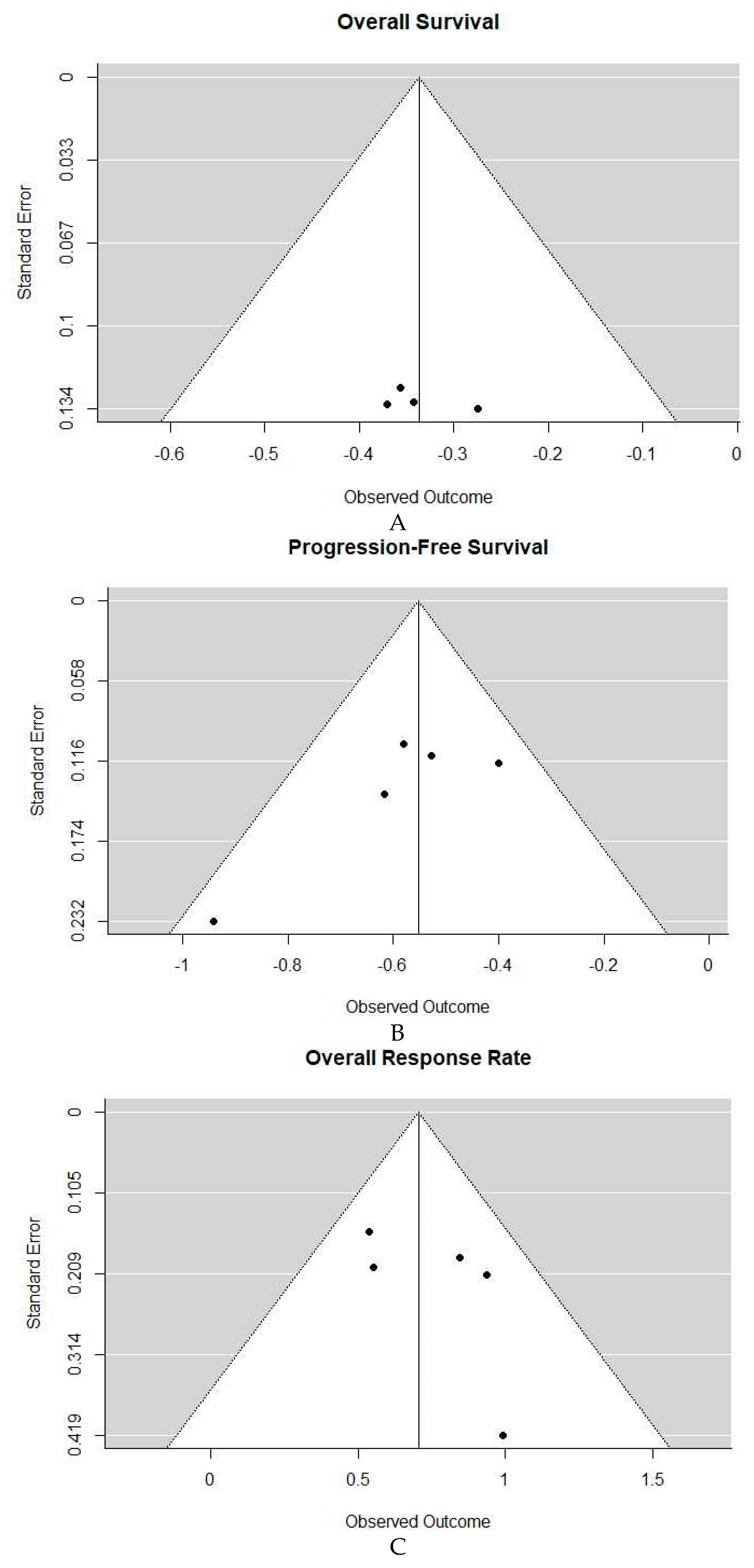

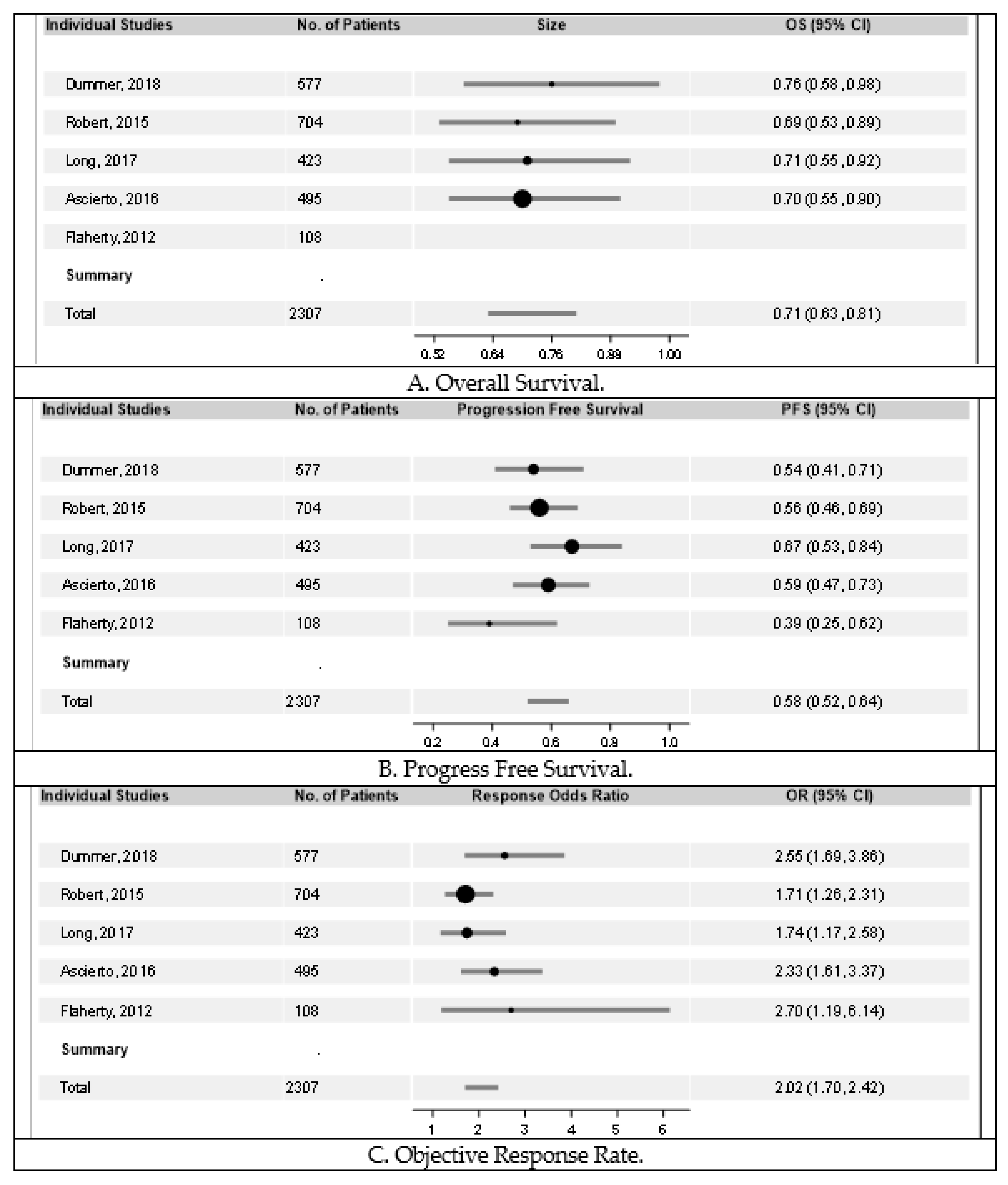
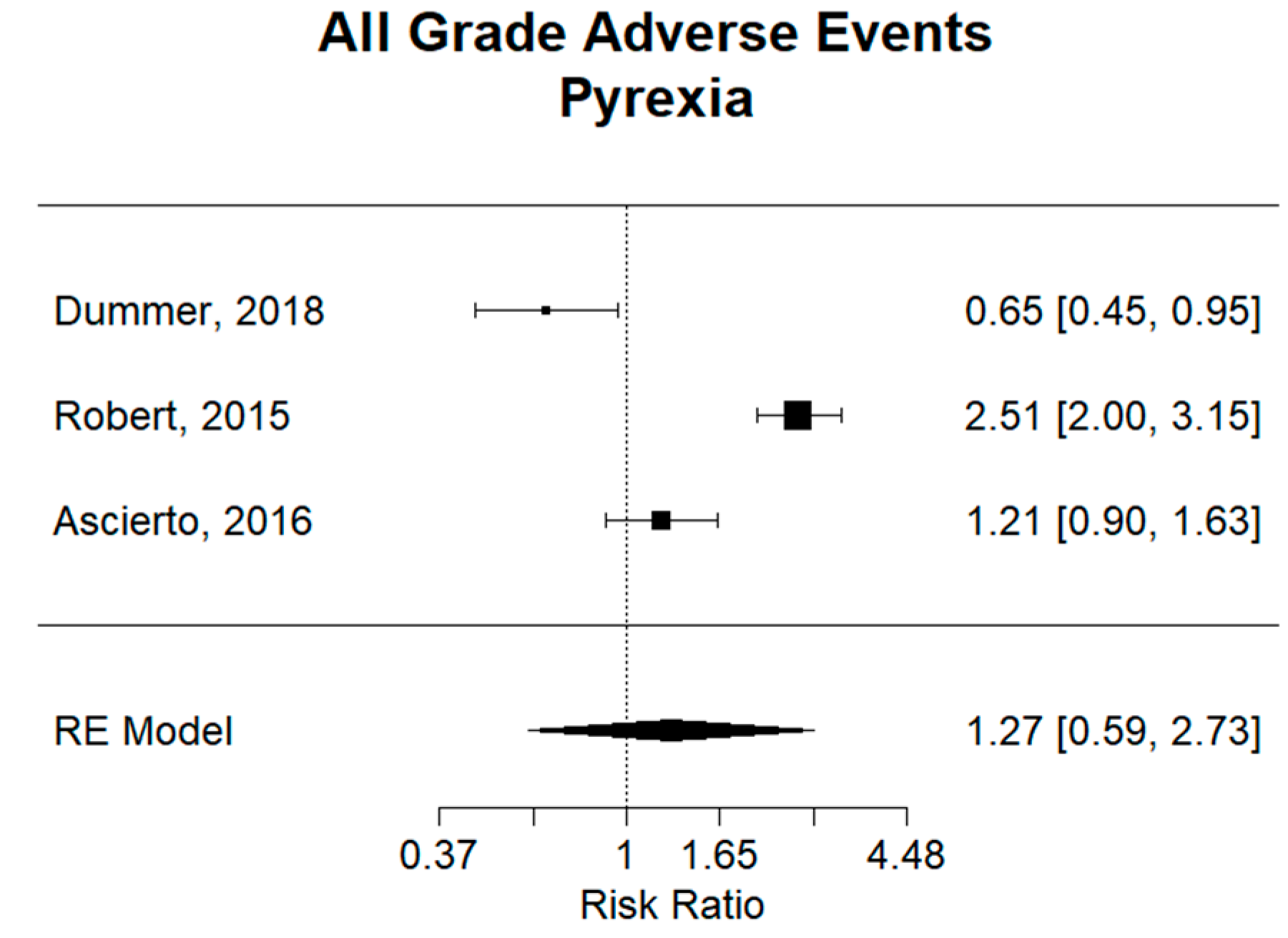
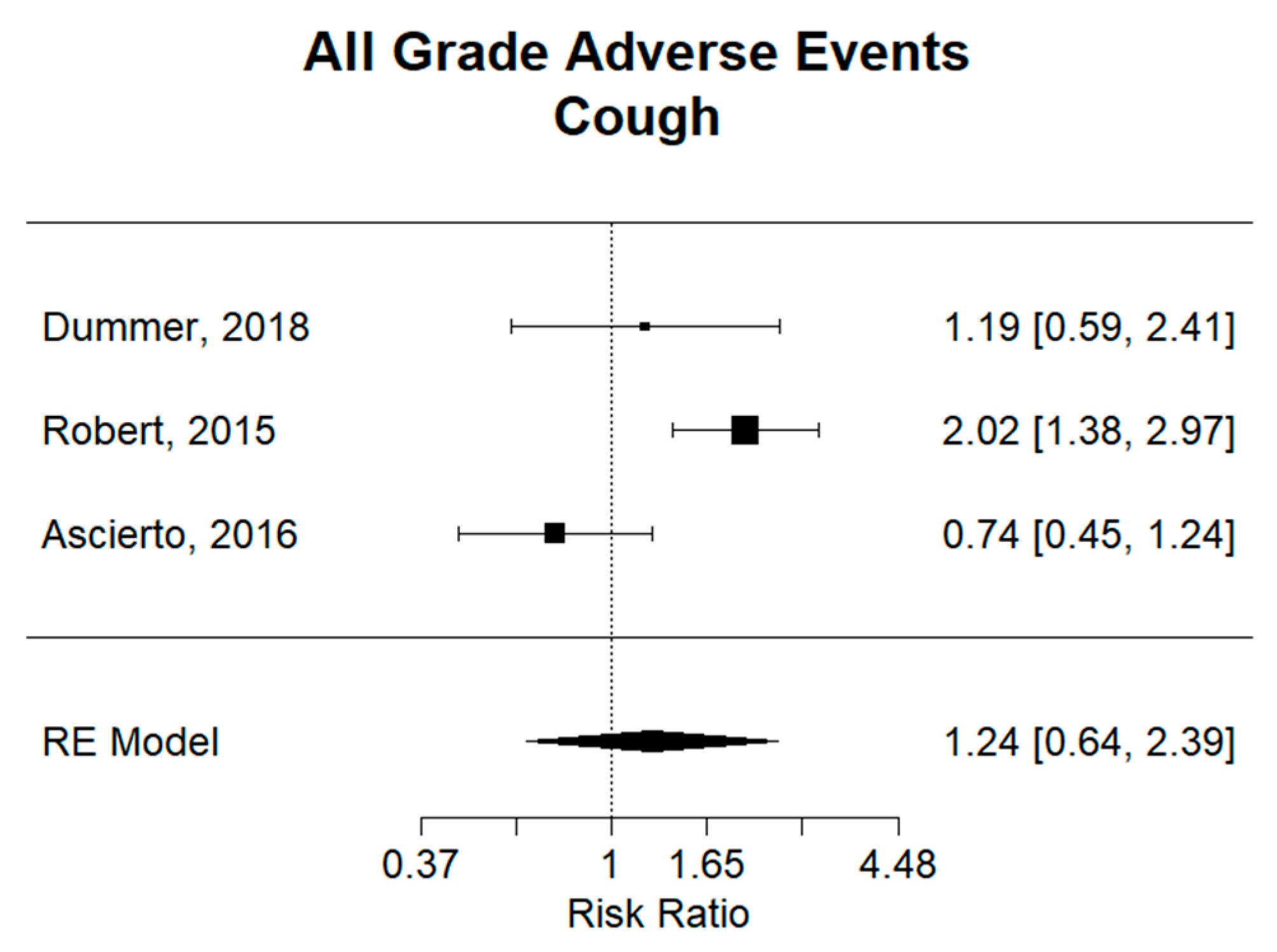
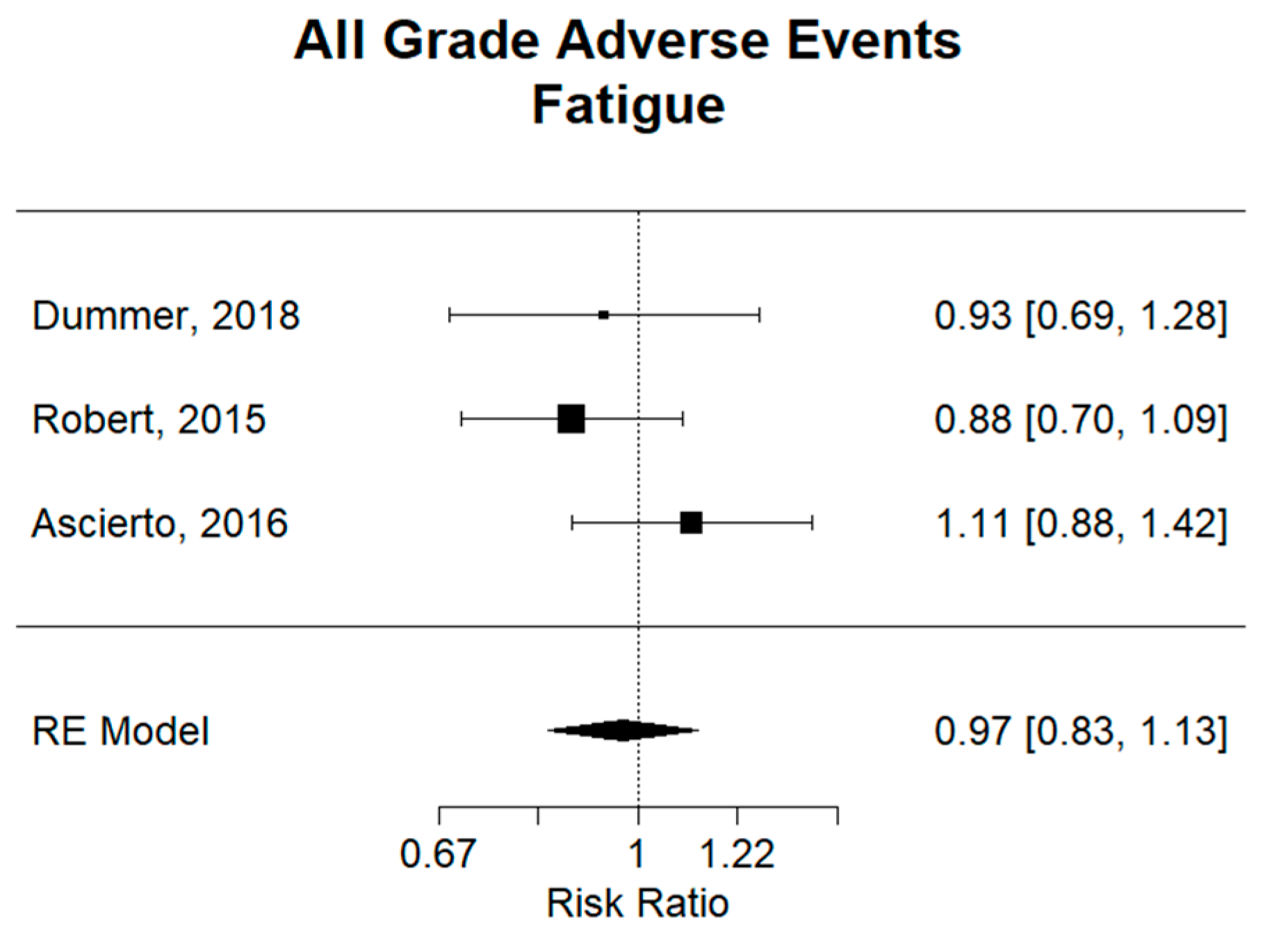
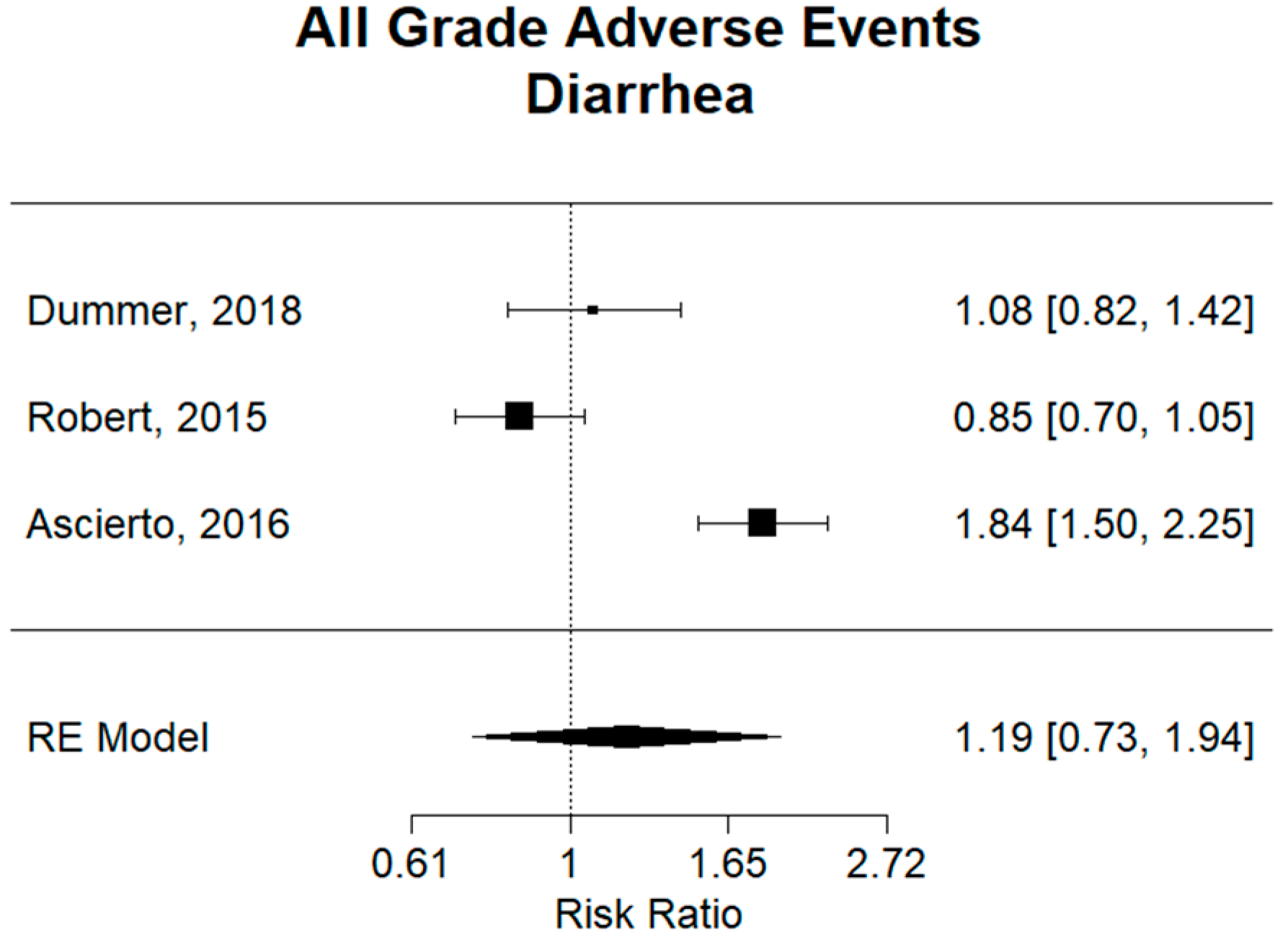
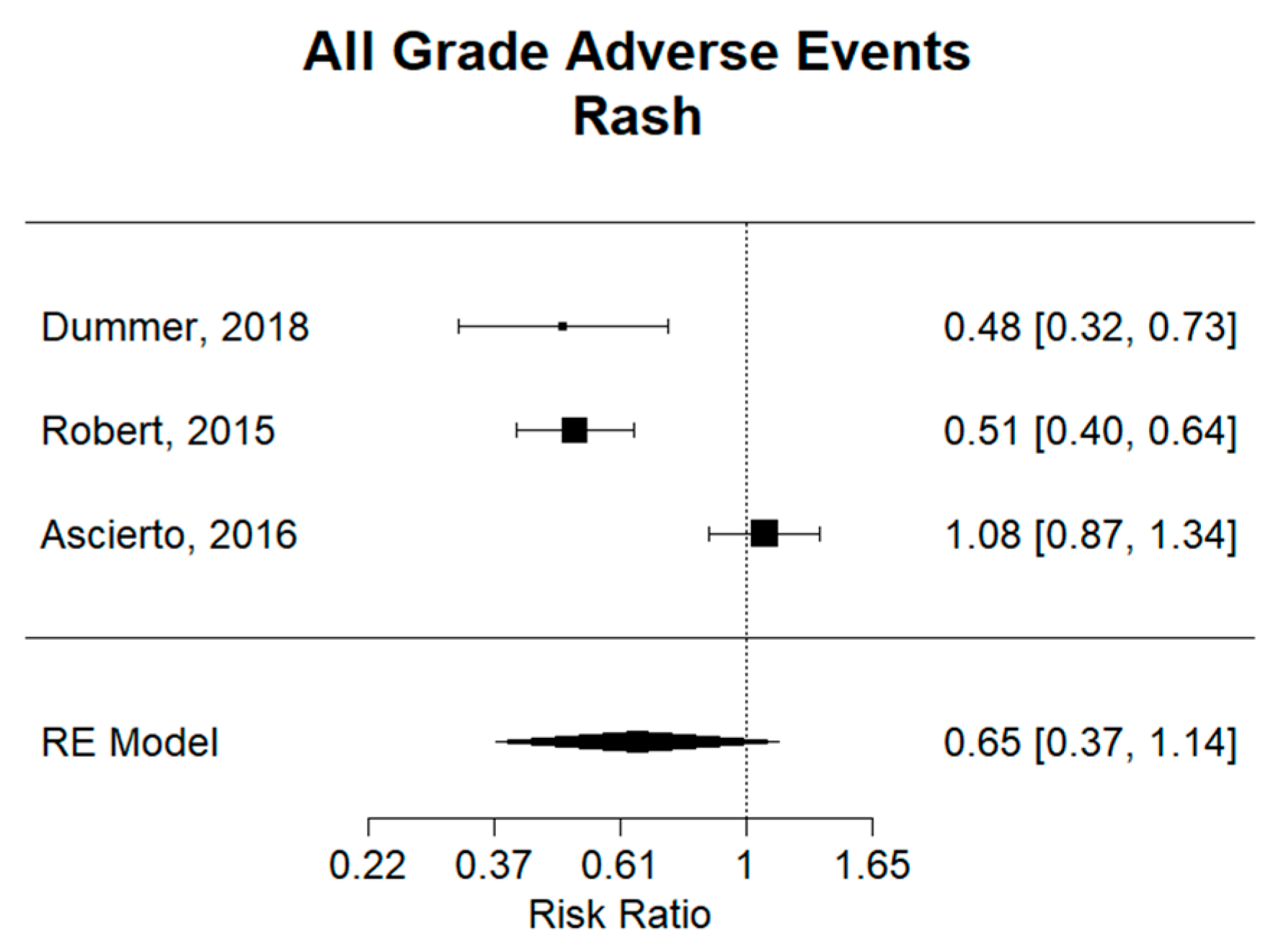
| Author | Study Dates | Region | Trial Design | Treatment Regimen | OS (median mos), Combination vs. Monotherapy | PFS (median mos), Combination vs. Monotherapy | ORR, Combination vs. Monotherapy | Follow-up (median mos), Combination vs. Monotherapy |
|---|---|---|---|---|---|---|---|---|
| Dummer et al. 2018 [13] | December 2013–April 2015 | Worldwide (162 centers, 28 countries) | Phase III encorafenib + binimetinib (N = 192) vs. vemurafenib (N = 191) | 450 mg qd + 45 mg bid vs. 960 mg bid | 33.6 vs. 16.9 | 14.9 vs. 7.3 | 63% vs. 40% | 16.7 vs. 14.4 |
| Robert et al. 2015 [12] | June 2012–October 2013 | Worldwide (193 centers) | Phase III dabrafenib + trametinib (N = 352) vs. vemurafenib (N = 352) | 150 mg bid + 2 mg qd vs. 960 mg bid | (NA), 17.2 | 11.4 vs. 7.3 | 64% vs. 51% | 11 vs. 19 |
| Long et al. 2017 [11] | May 2012–November 2012 | Worldwide (113 centers, 14 countries) | Phase III dabrafenib + trametinib (N = 211) vs. dabrafenib (N = 212) | 150 mg bid + 2 mg qd vs. 150 mg bid | 25.1 vs. 18.7 | 11.0 vs. 8.8 | 68% vs. 55% | 9 (all groups) |
| Ascierto et al. 2016 [9] | January 2013–January 2014 | Worldwide (135 centers, 19 countries) | Phase III vemurafenib + cobimetinib (N = 247) vs. vemurafenib (N = 248) | 960 mg bid + 60 mg qd vs. 960 mg bid | 22.3 vs. 17.4 | 12.3 vs. 7.2 | 70% vs. 50% | 14.2 (all groups) |
| Flaherty et al. 2012 [10] | March 2010–July2011 | Multi-national (16 centers) | Phase I/II dabrafenib + trametinib (N = 54) vs. dabrafenib (N = 54) | 150 mg bid + 2 mg qd vs. 150 mg bid | (NA) | 9.4 vs. 5.8 | 76% vs. 54% | 14.1 (all groups) |
© 2019 by the authors. Licensee MDPI, Basel, Switzerland. This article is an open access article distributed under the terms and conditions of the Creative Commons Attribution (CC BY) license (http://creativecommons.org/licenses/by/4.0/).
Share and Cite
Greco, A.; Safi, D.; Swami, U.; Ginader, T.; Milhem, M.; Zakharia, Y. Efficacy and Adverse Events in Metastatic Melanoma Patients Treated with Combination BRAF Plus MEK Inhibitors Versus BRAF Inhibitors: A Systematic Review. Cancers 2019, 11, 1950. https://doi.org/10.3390/cancers11121950
Greco A, Safi D, Swami U, Ginader T, Milhem M, Zakharia Y. Efficacy and Adverse Events in Metastatic Melanoma Patients Treated with Combination BRAF Plus MEK Inhibitors Versus BRAF Inhibitors: A Systematic Review. Cancers. 2019; 11(12):1950. https://doi.org/10.3390/cancers11121950
Chicago/Turabian StyleGreco, Austin, Danish Safi, Umang Swami, Tim Ginader, Mohammed Milhem, and Yousef Zakharia. 2019. "Efficacy and Adverse Events in Metastatic Melanoma Patients Treated with Combination BRAF Plus MEK Inhibitors Versus BRAF Inhibitors: A Systematic Review" Cancers 11, no. 12: 1950. https://doi.org/10.3390/cancers11121950
APA StyleGreco, A., Safi, D., Swami, U., Ginader, T., Milhem, M., & Zakharia, Y. (2019). Efficacy and Adverse Events in Metastatic Melanoma Patients Treated with Combination BRAF Plus MEK Inhibitors Versus BRAF Inhibitors: A Systematic Review. Cancers, 11(12), 1950. https://doi.org/10.3390/cancers11121950







